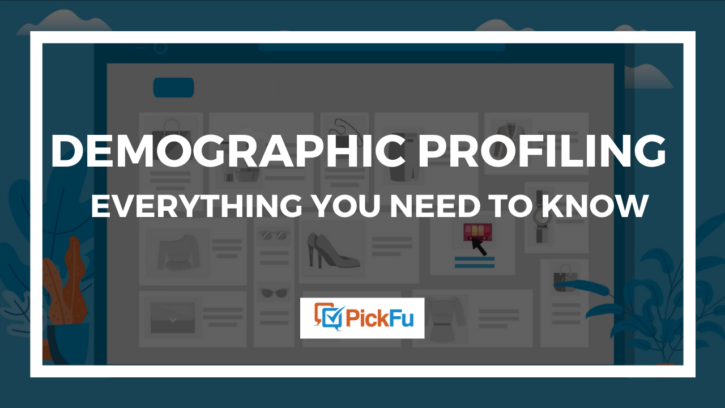What is demographic profiling?
Demographic profiling is a bit like creating a character for a novel or a film. Only instead of a fictional person for a story, you’re figuring out key demographic traits about the people who buy from your brand.
Here’s why that’s important: Understanding your target audience is essential to your success.
In a perfect world, most of the universe would be interested in what you’re selling. You’d have tons of business coming in from everywhere and could market your products to just about anyone.
But that’s simply not a realistic expectation. There are too many people in the world with all sorts of varying characteristics, interests, and expectations.
Why does demographic profiling matter?
To ensure brand success, you need to figure out who your customers are. Then you can create a marketing plan that’ll make them come running.
Demographic profiling will help you do this. To create a demographic profile, you collect demographic data about the customers you’re targeting, such as their:
- Age
- Gender
- Education
- Income
- Occupation
- Ethnicity
- Stage in Life (single, married, children, and so forth)
When you’ve collected data in these categories from your target audience, use it to create a demographic profile of your customer.
(Think of this as a description of your most common groups of customers.)
Demographic profiling helps you personalize your products, services, and advertisements. The more a campaign is personalized, the more likely a customer is to click and purchase.
Here’s how to do it.
Building a demographic profile for your business
Before you ever began building your brand, you probably had at least an idea of who your product would serve.
A company like Patagonia knows that it’s serving people who love the outdoors. (And who have extra cash to spend on pricey outerwear.)
Melissa & Doug, maker of bazillions of wooden and battery-free kids’ toys, wouldn’t send targeted ads to single women in their twenties.
So the first thing you need to do is narrow down your audience. If you’ve already been selling your product for a while, pay attention to who is buying.
Gather data
You can gather the data you need by:
- Running customer feedback surveys
- Checking your sales figures
- Hiring a market research firm to help you fill in the gaps
Then, take a look at all the data. What are the biggest similarities? What groups emerge from your research?
Take Melissa & Doug, for example. Might it be true that many of their customers are:
- Parents — often mothers — of young children (ages 0 to about 8)?
- Grandparents with young grandchildren?
- People who make between $75,000 and $150,000 a year? (M&D toys aren’t cheap!)
These are all common traits that can be built into a demographic profile for each group.
Create a table
Take this hypothetical demographic profile for a company that sells wooden, battery-free toys.
Say the company has three main groups of customers: parents, grandparents, and slightly older kids who might tell their caregivers what they like.
Parents are likely to be anywhere from 21-45 years old.
Grandparents will be around 50-85.
Kids will be anywhere from 2-8.
Taking their demographic data such as spending budget, location, and stage in life, write a description for each group.
Then, ask yourself this: what is most important to these customers? Create a table like the one below to make your demographic profile easier to digest.
Once you’ve built your demographic profile, you can better target your customers and make sure that your product is fulfilling their needs.
One of the easiest ways for you to make sure your brand is primed for your target demographic is to use PickFu.
How PickFu can help you
You did the work to build a demographic profile of your customers. Now it’s time to put that work to good use!
Let’s start off with a quick introduction to PickFu: it’s a feedback platform that is flexible,
The platform enables you to build polls and select the type of person who will respond to them.
With PickFu, you select your target audience, ask important questions about your products and brand, and gain insights that you can’t find anywhere else.
All you have to do is create a poll, pose a question, and choose your target audience.
PickFu does the heavy lifting
Say you’re an outwear company like Patagonia. You want to find out what your customers think about your innovative new hiking outfit.
It can turn into a swimsuit and dry out quickly — you know, for that on-a-hike creek or lake dips.
(Yes, I totally made this product up.)
Instead of your question going to 50 respondents from a general audience who may not even like to hike, you can choose to poll 50-500 people who are hiking enthusiasts.
If your demographic data shows that most of your customers are women over the age of 35, you can even combine those traits.
For example, you could target your question to a group of 50 women over the age of 35 who love to hike.
There’s no need for you to personally reach out to 50 women over the age of 35 who hike all the time. (That would be exhausting!)
PickFu does the searching and sorting for you. And results come back in as little as 15 minutes! Instead of toiling to find Facebook friends who fit your demographic profile, let PickFu do the work.
Asking an open-ended question
Once you’ve got your audience lined up, ask them a simple, open-ended question, such as “Would you purchase this product? Why or why not?”
Your audience will answer with a “yes” or “no” and give you detailed
Here’s what one male respondent had to say:
“I like that it has a pump on it. That helps with getting a consistent amount of product each time I use it.
The black color and not being flashy is right up my alley, and the shape makes it look like it would be easy to handle in the shower without it being slippery. I really like it and I would more than likely give it a shot.”
This is one response! See how incredibly detailed it is? The respondent offered specific feedback based on the product’s traits.
Another respondent said this:
“I like the black colored bottle with white lettering and the splash of blue, along with the shape of the bottle. I don’t care for the pegasus logo and the lettering should be bigger.”
PickFu respondents will always be honest about what they think, which is exactly what you need.
When that feedback comes from your target audience, it’s marketing gold.
Split testing
If you want to run a poll to choose between two different versions of a product, product listing, main image, or more, you can do that, too.
Simply post two (or more) versions of the product. Ask a simple question
Respondents will vote on their favorite, and they’ll also give you detailed feedback.
Take this poll, for example, where a company asked an audience of dog owners which image they’d click on in an Amazon results page:
Option B won by a whopping margin, and dog owners gave all sorts of sage advice as to why.
One respondent said, “I would choose Option B because it shows the picture of the box and what is included very clearly
If even a certified dog owner isn’t sure what an image is showing, you definitely don’t want to use that one in your Amazon listing.
The middle picture shows a clear, clutter-free setup that many dog owners will flock to.
What targetable traits can I choose on PickFu?
As you run polls, it’s important to use the demographic profile you built. This way, the feedback you solicit will come from the kind of people who use your products.
With PickFu’s wide range of targetable traits, you can easily ask your target audience, as defined by your demographic profile, any question you want.
Check out this always-growing list of traits you can select on PickFu:
Don’t forget that you can combine several of these traits to narrow your audience down to a specific demographic.
And don’t think that you have to run polls to only one specific group of people. If your demographic profile shows that you have three main demographic groups, you can run different polls that target the three groups separately.
For example, say you’re a publishing company. You’re trying to decide which cover for a fictional novel attracts readers the most readers. Your readership is 30 percent audiobook listeners and 70 percent print readers.
Since you can create different covers for the audiobook version and the print version, you ask the same question to the two different groups:
- Audiobook listeners who read 1, 2, 3, 4+ or more books a month and who read fiction
- Print readers who read 1, 2, 3, 4+ or more books a month and who read fiction
The insight you’ll get might be different between your two key demographic groups. You can then apply it to each version of your book cover accordingly.
The benefits of demographic profiling
The best thing about demographic profiling is that it helps narrow your audience into segments.
Studying each segment on its own is much easier than trying to understand your entire audience as a whole.
You can think of demographic profiling as a mode of organization. This organization helps you understand each demographic group and provide the product or service they want in the manner that they prefer.
Basically, demographic profiling is one of the most straightforward ways to make sure you’re giving your customers everything they deserve.
And happy customers will stick with you for years to come.
It’s easy to get started on PickFu, so once you’ve got your demographic profile built, it’s time to start polling!










